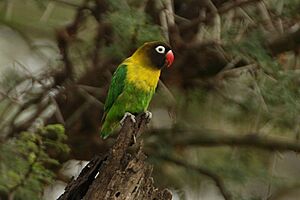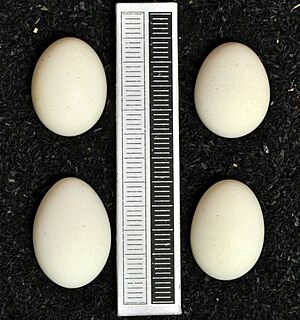Yellow-collared lovebird facts for kids
Quick facts for kids Yellow-collared lovebird |
|
|---|---|
 |
|
| In Serengeti, Tanzania | |
| Conservation status | |
| Scientific classification | |
 |
|
| Native range in northeast Tanzania | |
| Synonyms | |
|
The yellow-collared lovebird (Agapornis personatus) is a small, colorful parrot. It is also known as the masked lovebird because of its black face. These birds are part of the lovebird family. They originally come from the Arusha Region in Tanzania, Africa. You can also find them in Burundi and Kenya, where people have brought them. Sometimes, they are seen in places like Puerto Rico or Arizona, but these are usually pet birds that have escaped.
Contents
About the Yellow-Collared Lovebird
The yellow-collared lovebird is a small parrot, about 14.5 centimeters (5.5 inches) long. Most of its body is green. The feathers on its back are a darker green than those on its belly. Its head is black, which looks like a mask. It has a bright red beak and white rings around its eyes. A bright yellow band goes across its chest and around its neck. Male and female lovebirds look exactly the same.
Reproduction and Life Cycle
When male lovebirds want to find a mate, they move their heads up and down. They also slide excitedly towards the female. These birds often build their nests together in groups. They use strips of twigs and bark to make their nests. The female carries the nesting material in her beak to a hole in a tree.
Lovebird eggs are white. A female usually lays four or five eggs at a time. She sits on the eggs for about 23 days until they hatch. The baby birds, called chicks, stay in the nest for about 42 days after they hatch. Then, they are ready to leave the nest.
Yellow-Collared Lovebirds as Pets

Masked lovebirds are usually less aggressive than some other lovebird types. People often keep them in large enclosures called aviaries. Sometimes, different kinds of lovebirds are kept together. However, this can cause different species to breed and create mixed-breed birds. It's often best to keep lovebirds with their own kind. If you want to mix birds, make sure the aviary is very large. You can sometimes keep them safely with quails and pheasants.
Housing Your Lovebird
Lovebirds need perches of different sizes in their cages or aviaries. Natural branches are great because they have different shapes and angles. This helps keep their feet healthy and active. Always check if a plant is safe before putting it in a cage. Some plants like cherry wood, broom, kōwhai, and avocado are poisonous to parrots.
Lovebirds often use nesting boxes for sleeping all year round. It's a good idea to clean these boxes. You can give them willow branches or corn husks. The female lovebird will tear these up and use them to line her nest box.
Understanding Lovebird Colors
Lovebirds can come in many different colors. The blue color was first seen in wild birds in the 1920s. Other colors have been created by people breeding them. These colors include blue, cobalt, mauve, slate, violet, lutino, and albino.
These different colors happen because of small changes in their genes. For example, a lutino lovebird is yellow with an orange face. This happens because the genes for blue colors are not passed on. An albino lovebird is completely white. This color happens when the genes for all colors (blue, red, and yellow) are missing.
The "dilute" color makes the darker feathers lighter. This was first seen in green lovebirds. When dilute birds were bred with blue birds, they created a color now called "dilute blue."
Gallery









